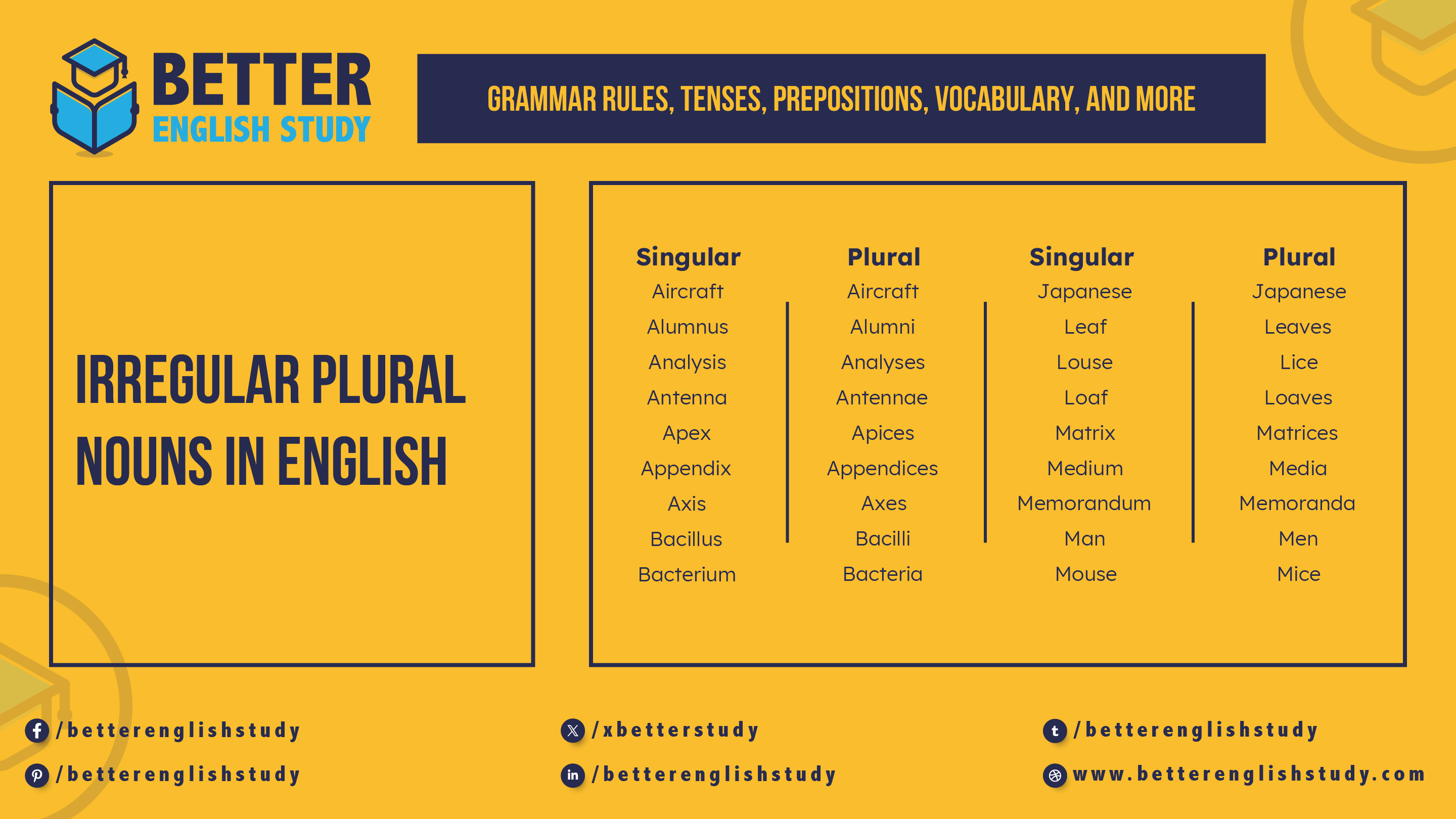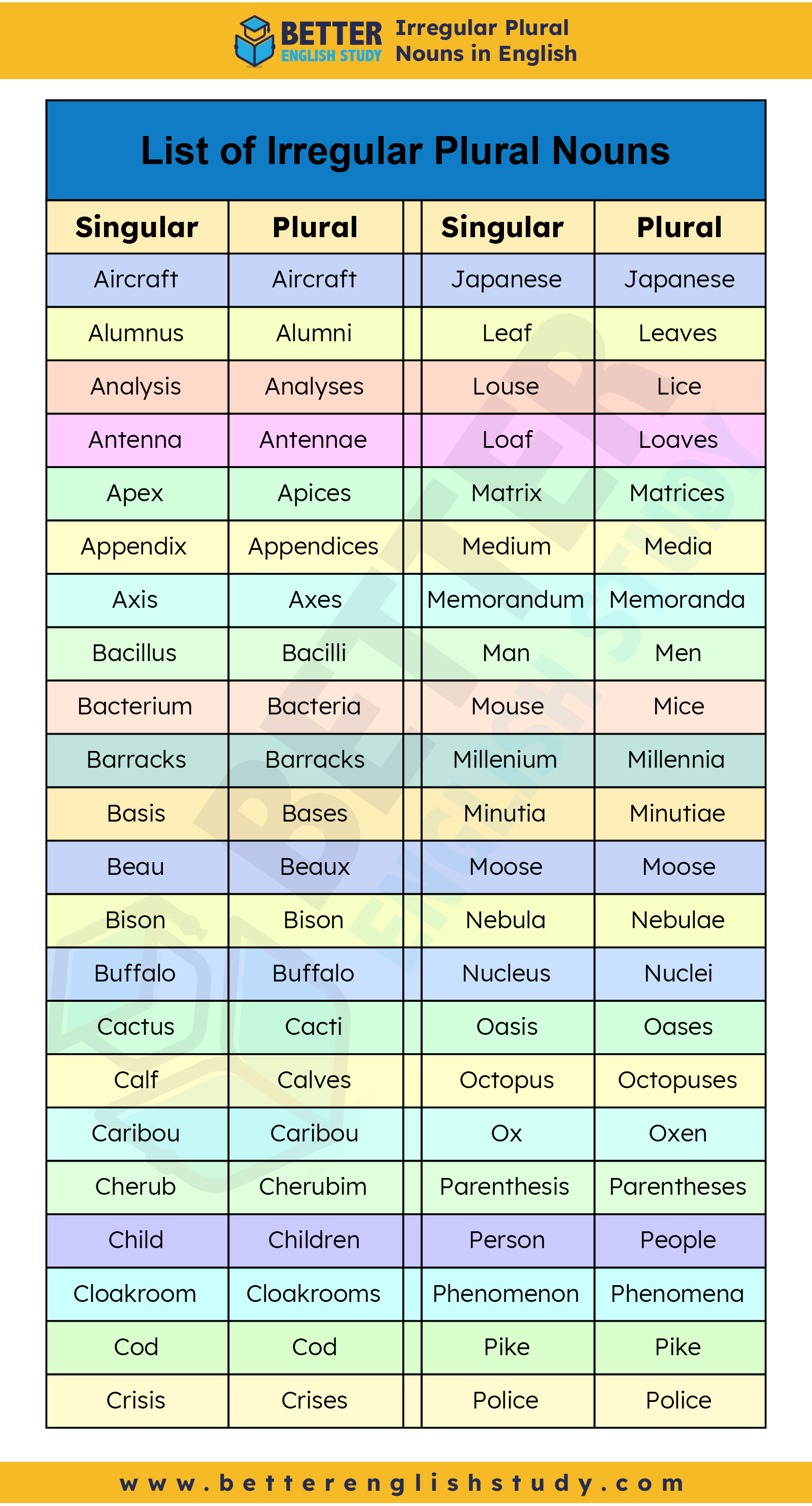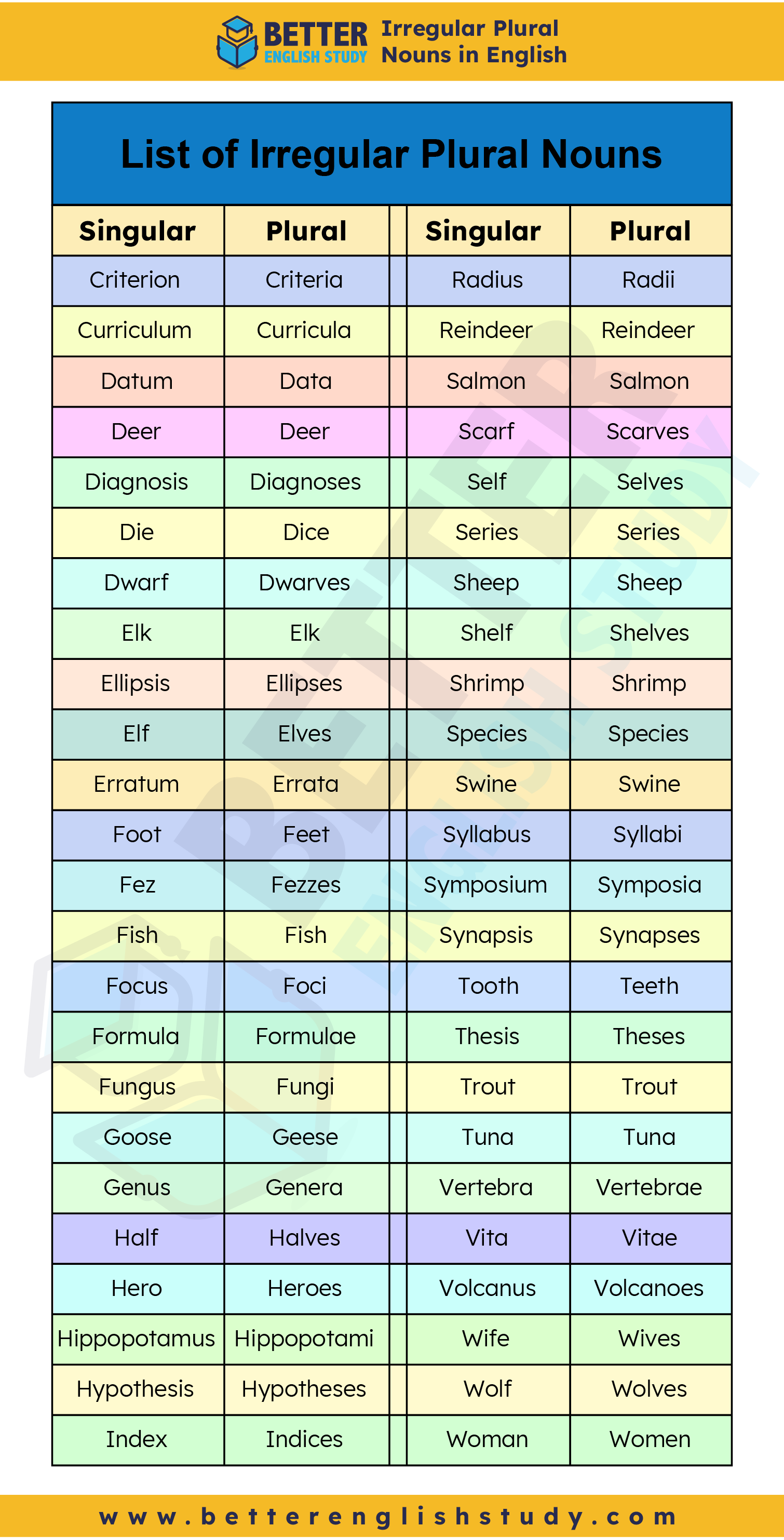
In the English language, most nouns follow a simple rule for forming plurals: add “-s” or “-es” to the end. However, a fascinating category known as irregular plural nouns deviates from these standard rules. These nouns often pose a challenge to learners due to their unique and unpredictable plural forms.
In this article, we’ll explore the concept of irregular plural nouns, how to identify them and provide illustrative examples.
What is an Irregular Plural Noun?
An irregular plural noun is a noun that does not follow the standard rules of pluralization, such as simply adding “-s” or “-es”. Instead, these nouns change their form entirely or follow different rules that can be traced back to Old English or other linguistic influences.
Examples of Irregular Plural Nouns
- Child becomes children.
- Explanation: Unlike regular nouns, “child” does not become “childs”. The word changes to “children” to indicate more than one child.
- Foot becomes feet.
- Explanation: The singular “foot” transforms into “feet” in the plural form, showcasing an irregular change.
- Mouse becomes mice.
- Explanation: Instead of adding a suffix, “mouse” changes internally to form the plural “mice.”
How to Identify Irregular Plural Nouns
Identifying irregular plural nouns involves recognizing that they do not conform to the usual rules of pluralization. Here are some tips and examples:
Tips for Identifying Irregular Plural Nouns:
- Internal Vowel Change:
- Example: “Man” changes to “men.”
- Explanation: Look for nouns that alter their internal vowels to form the plural.
- Unique Suffix Changes:
- Example: “Ox” becomes “oxen.”
- Explanation: Some nouns take unique suffixes like “-en” instead of “-s” or “-es.”
- Complete Word Changes:
- Example: “Person” changes to “people”.
- Explanation: Some irregular plurals involve a complete change in the word itself.
- Retaining Old English Forms:
- Example: “Goose” changes to “geese”.
- Explanation: Many irregular nouns retain plural forms from Old English or other linguistic roots.
- Pluralization of Foreign Words:
- Example: “Cactus” changes to “cacti”.
- Explanation: Nouns borrowed from other languages may have irregular plurals based on the original language’s rules.
List of some Irregular Plural Nouns with Their Singular form
| Singular | Plural | Singular | Plural | |
| Aircraft | Aircraft | Japanese | Japanese | |
| Alumnus | Alumni | Leaf | Leaves | |
| Analysis | Analyses | Louse | Lice | |
| Antenna | Antennae | Loaf | Loaves | |
| Apex | Apices | Matrix | Matrices | |
| Appendix | Appendices | Medium | Media | |
| Axis | Axes | Memorandum | Memoranda | |
| Bacillus | Bacilli | Man | Men | |
| Bacterium | Bacteria | Mouse | Mice | |
| Barracks | Barracks | Millenium | Millennia | |
| Basis | Bases | Minutia | Minutiae | |
| Beau | Beaux | Moose | Moose | |
| Bison | Bison | Nebula | Nebulae | |
| Buffalo | Buffalo | Nucleus | Nuclei | |
| Cactus | Cacti | Oasis | Oases | |
| Calf | Calves | Octopus | Octopuses | |
| Caribou | Caribou | Ox | Oxen | |
| Cherub | Cherubim | Parenthesis | Parentheses | |
| Child | Children | Person | People | |
| Cloakroom | Cloakrooms | Phenomenon | Phenomena | |
| Cod | Cod | Pike | Pike | |
| Crisis | Crises | Police | Police | |
| Criterion | Criteria | Radius | Radii | |
| Curriculum | Curricula | Reindeer | Reindeer | |
| Datum | Data | Salmon | Salmon | |
| Deer | Deer | Scarf | Scarves | |
| Diagnosis | Diagnoses | Self | Selves | |
| Die | Dice | Series | Series | |
| Dwarf | Dwarves | Sheep | Sheep | |
| Elk | Elk | Shelf | Shelves | |
| Ellipsis | Ellipses | Shrimp | Shrimp | |
| Elf | Elves | Species | Species | |
| Erratum | Errata | Swine | Swine | |
| Foot | Feet | Syllabus | Syllabi | |
| Fez | Fezzes | Symposium | Symposia | |
| Fish | Fish | Synapsis | Synapses | |
| Focus | Foci | Tooth | Teeth | |
| Formula | Formulae | Thesis | Theses | |
| Fungus | Fungi | Trout | Trout | |
| Goose | Geese | Tuna | Tuna | |
| Genus | Genera | Vertebra | Vertebrae | |
| Half | Halves | Vita | Vitae | |
| Hero | Heroes | Volcanus | Volcanoes | |
| Hippopotamus | Hippopotami | Wife | Wives | |
| Hypothesis | Hypotheses | Wolf | Wolves | |
| Index | Indices | Woman | Women |


10 Example Sentences of Irregular Plural Nouns with Explanations
- Child / Children
- Singular: The child is playing in the park.
- Plural: The playground is filled with happy children.
- Foot / Feet
- Singular: He injured his foot during the game.
- Plural: Both of his feet were sore after the hike.
- Mouse / Mice
- Singular: There is a mouse in the kitchen.
- Plural: The house was infested with mice.
- Tooth / Teeth
- Singular: She lost a tooth.
- Plural: He has a set of healthy teeth.
- Person / People
- Singular: There was only one person at the bus stop.
- Plural: Many people attended the concert.
- Goose / Geese
- Singular: We saw a goose near the pond.
- Plural: A flock of geese flew overhead.
- Man / Men
- Singular: The man was very tall.
- Plural: The men were all dressed in suits.
- Leaf / Leaves
- Singular: The leaf fell from the tree.
- Plural: The ground was covered with fallen leaves.
- Deer / Deer
- Singular: A deer is grazing in the field.
- Plural: We saw several deer in the forest.”
- Cactus / Cacti
- Singular: “There is a cactus on the windowsill.”
- Plural: “The desert was dotted with cacti.”
In conclusion, understanding irregular plural nouns enriches our grasp of English grammar. These nouns, with their unique plural forms, add depth and variety to our language. By recognizing the patterns and memorizing their forms, we can master their usage and appreciate the linguistic diversity they bring to English.
